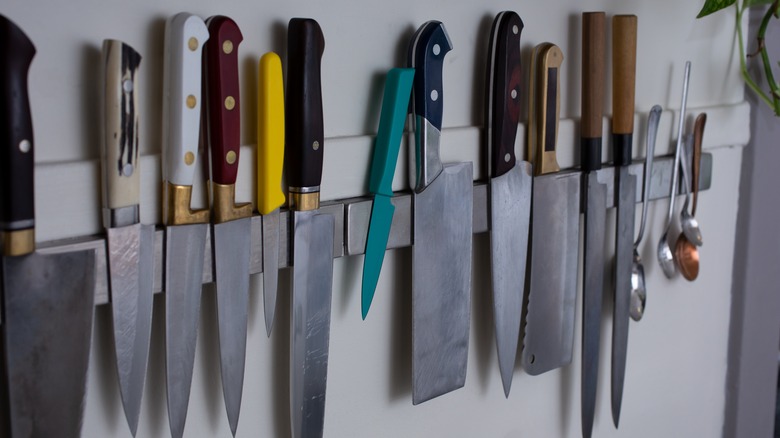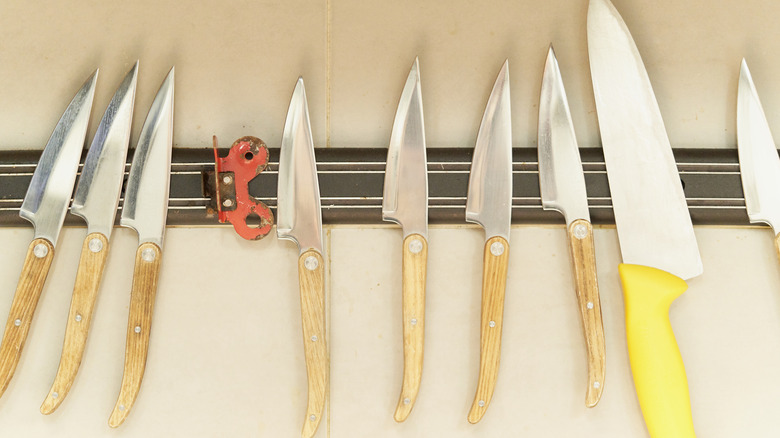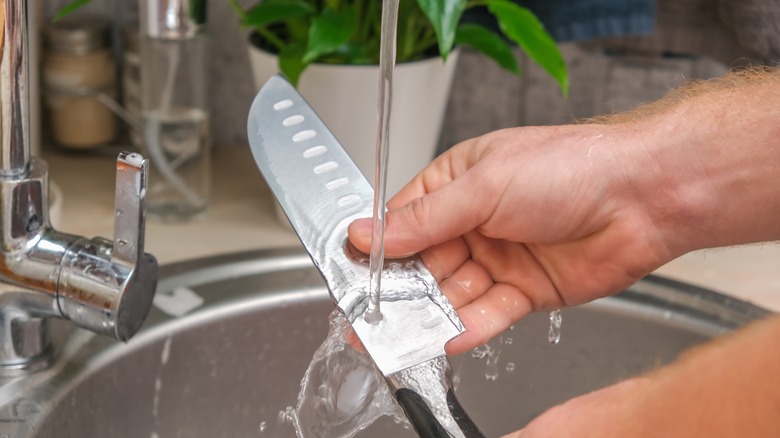The Downside Of A Magnetic Knife Strip Is Easy To Avoid
Storing kitchen knives is admittedly a little tricky. If you have the counter space, it's tempting to go with a traditional knife block, however, these can dull your blades over time from sliding them across the surface of the wood. Then there are drawer inserts, which have the same blade contact problem as blocks, plus you need to dedicate an entire drawer to just knives. Magnet strips eliminate the space requirements of blocks and drawers, and your blades won't touch anything, which is a win/win. With that said, magnetic strips are not foolproof. If you store wet or dirty knives, magnetic strips can degrade the blades over time if you're not careful. Thankfully it's easy to avoid damaging your blades as long as you make sure to clean the magnetic strip periodically, and only store clean, dry knives.
There is some debate amongst cooks as to whether magnetic knife strips are safe, but for the most part, they will not cause damage to your knives if you use them properly. Just choose a model that has a strong enough magnet to hold the knives safely and securely, and wipe it down whenever you clean off your kitchen counters to keep it in good shape and free from damaging rust.
Metal knife strips can transfer rust and create scratches
A magnetic knife strip is a pretty simple tool; it's just a magnetized bar that's mounted to the wall to hold knives by the sides of their blades. With that said, there are two different types of knife magnet strips: Exposed metal and wooden-covered models.
Knife strips with exposed metal magnets will certainly do the job if you're on a budget, however, if you have a few extra dollars to spend, go for a wood-covered model even if you only own a few essential blades. A layer of wood between your knife and the magnet will protect the side of the blade from scratches when you attach and detach it from the strip. Not only that, exposed metal magnets are prone to rusting if they get wet (or even damp), which can transfer over to your blade, especially those made of carbon steel.
Whatever model you choose, make sure to keep your magnetic knife strip clean. Wooden-covered strips need to be wiped down and polished from time to time to keep them in good shape, much like a good cutting board. Metal models also need a once-over periodically to make sure they're not collecting rust or residue. Whenever you're wiping down the counter and there's a little space on the strip, give it a quick sweep with a soapy sponge and then dry it thoroughly with a clean paper towel.
Don't store wet or dirty knives
For all the debate about how to store knives, the vast majority of the damage done to expensive knives happens from storing them wet or dirty.
Knives can, and will, start to rust whenever they're exposed to anything wet. A stainless steel knife can show spots of rust in anywhere from 45 minutes to a few hours, and carbon steel will start discoloring in less than 10 minutes. With this in mind, don't attach a wet knife to a magnetic knife block to dry, even if it's covered with wood, and definitely don't shove it into a knife block. It's also not a bad idea to wrap carbon steel blades with a little newspaper to keep them extra dry.
Also, don't let knives sit around when they're dirty. Food bits will stick to the knife and dry out, making it harder to clean, and naturally occurring acids in foods like tomatoes and lemons can discolor a carbon steel blade. Residue from dirty knives will also build up on your magnetic knife strip and create a food safety hazard, and for the same reason, it's also a bad idea to mount magnetic knife strips over the stove, because it will collect airborne grease and particles.
It only takes a minute to wipe down and dry a knife before you eat, so don't skip these important steps. Your knives (and magnetic knife strip) will reward you with decades of use if you treat them right.


